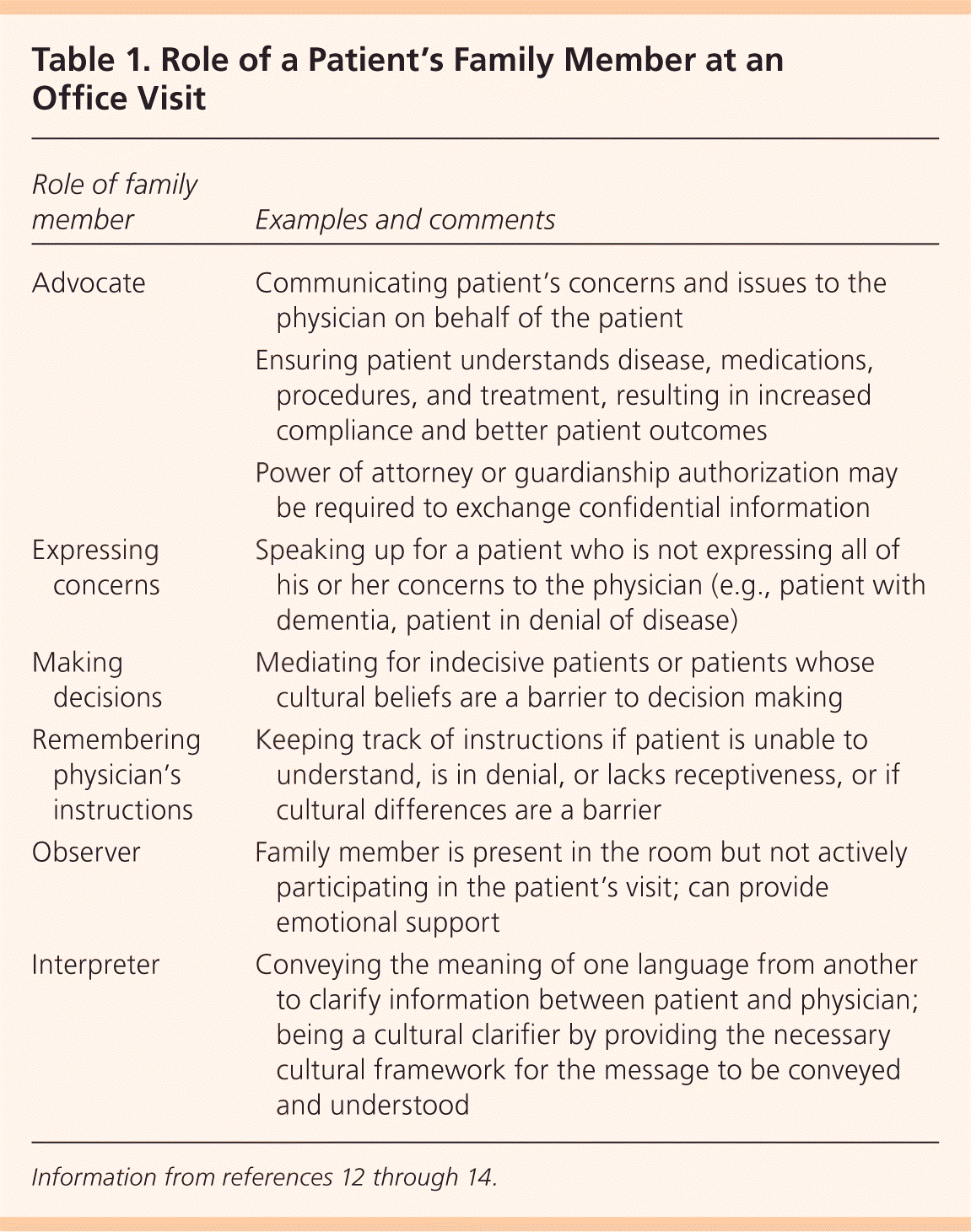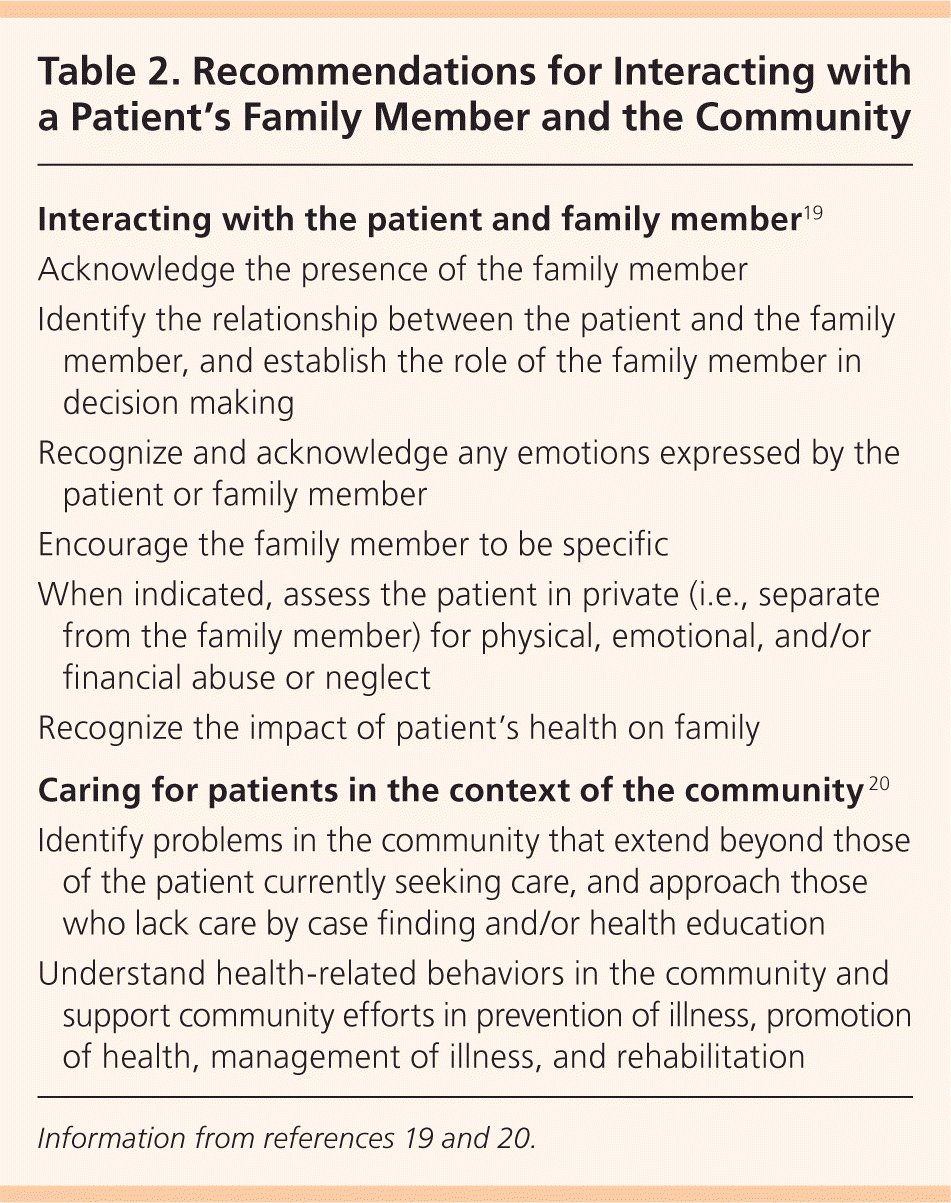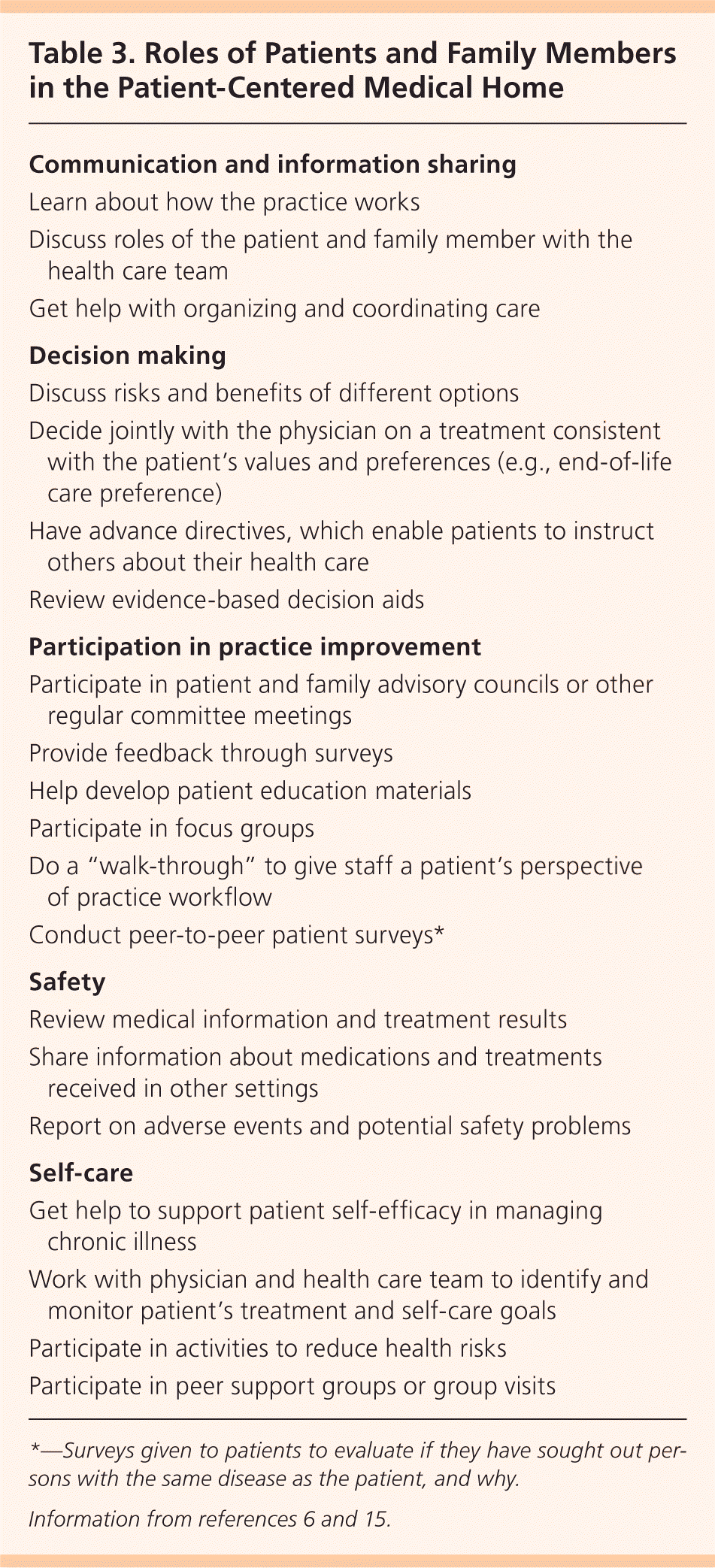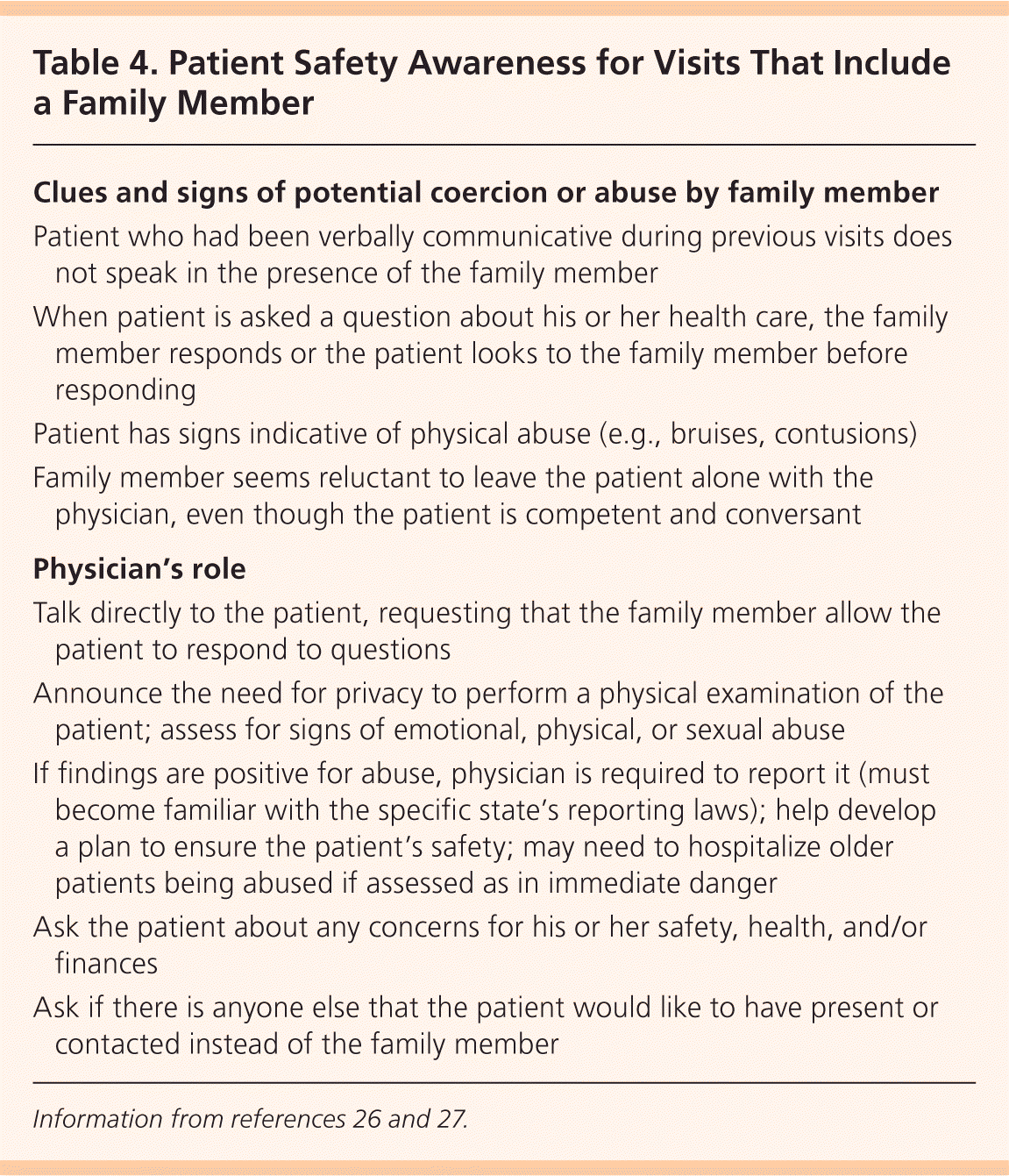
Am Fam Physician. 2011;84(7):780-784
Patient information: See related handout for family members at office visits, written by the authors of this article.
Author disclosure: No relevant financial affiliations to disclose.
The physician-patient relationship is part of the patient's larger social system and is influenced by the patient's family. A patient's family member can be a valuable source of health information and can collaborate in making an accurate diagnosis and planning a treatment strategy during the office visit. However, it is important for the physician to keep an appropriate balance when addressing concerns to maintain the alliance formed among physician, patient, and family member. The patient-centered medical home, a patient care concept that helps address this dynamic, often involves a robust partnership among the physician, the patient, and the patient's family. During the office visit, this partnership may be influenced by the ethnicity, cultural values, beliefs about illness, and religion of the patient and his or her family. Physicians should recognize abnormal family dynamics during the office visit and attempt to stay neutral by avoiding triangulation. The only time neutrality should be disrupted is if the physician suspects abuse or neglect. It is important that the patient has time to communicate privately with the physician at some point during the visit.
The physician-patient relationship is part of the patient's larger social system and is influenced by members of the patient's family.1 There are several relationship dynamics involved in this context, such as those between the physician and the patient, the patient and his or her family, the physician and the patient's family, and the patient and society.2 Patients often believe that the presence of a family member leads to an atmosphere of greater empathy and compassion from the professional health care team.3,4 The purpose of this article is to identify and understand each person's role during an office visit when the patient is accompanied by a family member.
| Clinical recommendations | Evidence Rating | References |
|---|---|---|
| Involvement of family members in the care of the patient improves communication among the physician, patient, and family, and helps with making an accurate diagnosis and planning treatment. | C | 4, 12, 13, 16, 17 |
| The physician should determine the reason for the presence of any family member accompanying the patient. | C | 5, 21 |
| The physician must avoid breach of patient confidentiality when discussing private health information in the presence of family members without expressed patient permission. | C | 5, 15, 28 |
Definition of Family
Considering the growing cultural diversity with traditional and nontraditional families, the term “family” could be defined as any group of persons who are related biologically, emotionally, or legally.1,5 Examples of nontraditional families are blended families, unmarried couples, and gay and lesbian couples or families.1,6,7 Family members who may accompany a patient to an office visit include children, siblings, parents, spouses or significant others, hired caregivers, interpreters, neighbors, friends, and clergy or church members.
Managing the Office Visit
Family members are present about one-third of the time in the examination room,8 and their presence usually prolongs the visit by only a few minutes.9 Those more likely to have a family member present include patients with a low level of health literacy, patients with a chronic disease, older patients, women, gay or lesbian patients, non–English-speaking patients, and children.6,7
The background of the patient's family (e.g., ethnicity, cultural values, religion, attitudes and beliefs about illness) is ever-present during the office visit, and this plays a role in the patient's decision making.1 The patient and his or her family member mutually influence each other and the patient-physician relationship, creating a therapeutic triangle.10
THE FAMILY MEMBER'S ROLE
There are a variety of reasons why a family member may accompany a patient to an office visit. It is common for a family member to be there to offer support during visits that may involve receiving bad news about the patient's health. Other common reasons include if the patient needs help communicating with the physician (e.g., language barrier, hearing or vision impairment) or if the patient has a physical or mental impairment or disability. For some patients, it may be a part of their family's habits or culture, or the age of the patient may be a factor, such as with older patients or children. Family members are the most central and enduring influence in the lives of children, whose health and well-being are linked to their parents' physical, emotional, and social health; social circumstances; and child-rearing practices.11
Whatever the reasons for their presence, family members can be a valuable part of the health care team (Table 112–14 ). Family members help patients manage and cope with illness.15 They also can be valuable sources of health information and can act as collaborators in making an accurate diagnosis and planning a treatment strategy.4,12,13,16,17 However, there must be a balance in the concerns addressed during the visit to maintain the alliance formed among patient, physician, and family member.16,18

| Role of family member | Examples and comments |
|---|---|
| Advocate | Communicating patient's concerns and issues to the physician on behalf of the patient |
| Ensuring patient understands disease, medications, procedures, and treatment, resulting in increased compliance and better patient outcomes | |
| Power of attorney or guardianship authorization may be required to exchange confidential information | |
| Expressing concerns | Speaking up for a patient who is not expressing all of his or her concerns to the physician (e.g., patient with dementia, patient in denial of disease) |
| Making decisions | Mediating for indecisive patients or patients whose cultural beliefs are a barrier to decision making |
| Remembering physician's instructions | Keeping track of instructions if patient is unable to understand, is in denial, or lacks receptiveness, or if cultural differences are a barrier |
| Observer | Family member is present in the room but not actively participating in the patient's visit; can provide emotional support |
| Interpreter | Conveying the meaning of one language from another to clarify information between patient and physician; being a cultural clarifier by providing the necessary cultural framework for the message to be conveyed and understood |
THE PHYSICIAN'S ROLE
The presence of a family member during a patient encounter introduces unique considerations that require an expanded interviewing skill set from the physician5 (Table 219,20 ). It is important to recognize and encourage the family member as a source of valuable information and support.12,13,21 The degree to which the family member feels supported by the physician may influence the family member's burden, attitude, and emotional health status.15

| Interacting with the patient and family member19 |
| Acknowledge the presence of the family member |
| Identify the relationship between the patient and the family member, and establish the role of the family member in decision making |
| Recognize and acknowledge any emotions expressed by the patient or family member |
| Encourage the family member to be specific |
| When indicated, assess the patient in private (i.e., separate from the family member) for physical, emotional, and/or financial abuse or neglect |
| Recognize the impact of patient's health on family |
| Caring for patients in the context of the community20 |
| Identify problems in the community that extend beyond those of the patient currently seeking care, and approach those who lack care by case finding and/or health education |
| Understand health-related behaviors in the community and support community efforts in prevention of illness, promotion of health, management of illness, and rehabilitation |
The office visit should involve asking the patient and his or her family member about the nature of their relationship, the family member's role in the care of the patient, and the reason for the presence of the family member.5,21 It is important for physicians to maintain their relationship with the patient and be observant of the patient's role in the family member's presence. Physicians should always remember to whom they are primarily responsible. Any additional concerns of the family member should be addressed only after taking care of the patient's issues and concerns.
The Patient-Centered Medical Home. There is compelling evidence that patient-centered communication improves clinical outcomes.17,22 The role of a family physician is enhanced within the concept of the patient-centered medical home, an approach to health care that recognizes the role of patients and their families in providing medical care (Table 36,15 ). This approach encourages collaboration among the patient, family, and health care clinicians, respecting individual and family strengths, cultures, traditions, and expertise. The patient-centered medical home performs these functions well by emphasizing the following principles: care is being provided for a person, not a condition; the patient is best understood in the context of his or her family, culture, values, and goals; and honoring that context will result in better health care, safety, and patient satisfaction.23 Additional information and resources about the patient-centered medical home are available online from the American Academy of Family Physicians at https://www.aafp.org/online/en/home/membership/initiatives/pcmh/aafpleads/aafppcmh.html.

| Communication and information sharing |
| Learn about how the practice works |
| Discuss roles of the patient and family member with the health care team |
| Get help with organizing and coordinating care |
| Decision making |
| Discuss risks and benefits of different options |
| Decide jointly with the physician on a treatment consistent with the patient's values and preferences (e.g., end-of-life care preference) |
| Have advance directives, which enable patients to instruct others about their health care |
| Review evidence-based decision aids |
| Participation in practice improvement |
| Participate in patient and family advisory councils or other regular committee meetings |
| Provide feedback through surveys |
| Help develop patient education materials |
| Participate in focus groups |
| Do a “walk-through” to give staff a patient's perspective of practice workflow |
| Conduct peer-to-peer patient surveys* |
| Safety |
| Review medical information and treatment results |
| Share information about medications and treatments received in other settings |
| Report on adverse events and potential safety problems |
| Self-care |
| Get help to support patient self-efficacy in managing chronic illness |
| Work with physician and health care team to identify and monitor patient's treatment and self-care goals |
| Participate in activities to reduce health risks |
| Participate in peer support groups or group visits |
Challenges
Although the patient-centered medical home approach recognizes the role of the family in providing medical care, the family member's presence also may add challenges to the visit.
PATIENT SAFETY
Patients may be vulnerable to abuses of power within their families.24 Although the U.S. Preventive Services Task Force found insufficient evidence to recommend for or against routine family and intimate partner violence screening,25 patients should be given a chance to express their concerns in private if there is any suspicion of neglect or physical, emotional, and/or financial abuse (Table 426,27 ). A private discussion time between the patient and physician should be set aside in most encounters, especially initially, so the physician can address concerns about whether a family member is acting in the patient's best interest and whether the patient feels safe and well cared for. The physical examination may present an opportunity to request time alone with the patient.5,21 The physician can use this time to elicit fears or concerns; obtain the names of other family caregivers the patient might want the physician to contact; and determine whether the patient requires legal or social services.15 Physicians need to be familiar with specific state reporting statutes and the implications of reporting patient neglect, abuse, or exploitation.15

| Clues and signs of potential coercion or abuse by family member |
| Patient who had been verbally communicative during previous visits does not speak in the presence of the family member |
| When patient is asked a question about his or her health care, the family member responds or the patient looks to the family member before responding |
| Patient has signs indicative of physical abuse (e.g., bruises, contusions) |
| Family member seems reluctant to leave the patient alone with the physician, even though the patient is competent and conversant |
| Physician's role |
| Talk directly to the patient, requesting that the family member allow the patient to respond to questions |
| Announce the need for privacy to perform a physical examination of the patient; assess for signs of emotional, physical, or sexual abuse |
| If findings are positive for abuse, physician is required to report it (must become familiar with the specific state's reporting laws); help develop a plan to ensure the patient's safety; may need to hospitalize older patients being abused if assessed as in immediate danger |
| Ask the patient about any concerns for his or her safety, health, and/or finances |
| Ask if there is anyone else that the patient would like to have present or contacted instead of the family member |
PATIENT CONFIDENTIALITY
The physician must exercise care to avoid a potential breach of the Health Insurance Portability and Accountability Act (HIPAA), which states that health professionals may share relevant health care information with the family member only if the patient agrees to, or does not object to, the disclosure.5,15 A cross-sectional survey of family physician respondents found that 95 percent provided private health information to a patient's family member, but only 56 percent asked their patients for permission to share this private health information.28 However, HIPAA should not be viewed as a barrier to communication.15 Maintaining and respecting confidentiality is of utmost importance, and priority should always be given to the patient's right to privacy and confidentiality.5 This is why it is imperative that the patient has time to communicate privately with the physician at some point during the visit.
FAMILY DYNAMICS AND TRIANGULATION
Physicians should recognize abnormal family dynamics during the office visit and attempt to stay neutral by avoiding triangulation (i.e., when two persons are in conflict, each will try to align with a third).5,12,21,29 To achieve maximum neutrality, physicians should not take the side of the family member or the patient. The only time neutrality should be violated is if physicians suspect abuse or neglect.29 Any other family conflict that remains unresolved may be referred to a family therapist, particularly if there is a chance that these issues might interfere with the patient's health care planning.5
Illustrative Case
A 56-year-old man is evaluated and diagnosed with depression during an office visit that includes his wife. His physician recommends beginning treatment with an anti-depressant. The patient is undecided about taking the medication, but his wife insists that he begin treatment with the medication. She also requests refills for her own medications.
Interpretation: The presence of the patient's wife brings potential benefits, including the provision of a more complete history of diagnosis, such as duration of symptoms and impact on well-being. Although the wife's values could be imparted into the decision making, her presence also constitutes a liability. The physician can best navigate the demands of this encounter by maintaining a primary focus on the patient's needs. If the patient's wife interferes with this focus, the physician should know when to excuse her and talk to the patient in private. From a legal perspective, the physician should avoid making the wife the sole decision maker if the patient is competent. Regarding the wife's request for refills, the physician should limit curbside consultations and encourage her to make a separate appointment for herself.
